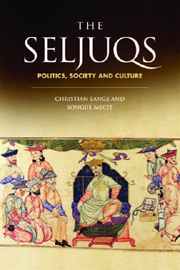Book contents
- Frontmatter
- Contents
- List of figures
- Acknowledgements
- List of abbreviations
- INTRODUCTION
- PART I POLITICS
- 1 THE ORIGINS OF THE SELJUQS
- 2 ASPECTS OF THE COURT OF THE GREAT SELJUQS
- 3 ‘SOVEREIGN AND PIOUS’: THE RELIGIOUS LIFE OF THE GREAT SELJUQ SULTANS
- 4 KINGSHIP AND IDEOLOGY UNDER THE RUM SELJUQS
- 5 SELJUQ LEGITIMACY IN ISLAMIC HISTORY
- PART II SOCIETY
- Part III CULTURE
- Index
2 - ASPECTS OF THE COURT OF THE GREAT SELJUQS
from PART I - POLITICS
Published online by Cambridge University Press: 12 September 2012
- Frontmatter
- Contents
- List of figures
- Acknowledgements
- List of abbreviations
- INTRODUCTION
- PART I POLITICS
- 1 THE ORIGINS OF THE SELJUQS
- 2 ASPECTS OF THE COURT OF THE GREAT SELJUQS
- 3 ‘SOVEREIGN AND PIOUS’: THE RELIGIOUS LIFE OF THE GREAT SELJUQ SULTANS
- 4 KINGSHIP AND IDEOLOGY UNDER THE RUM SELJUQS
- 5 SELJUQ LEGITIMACY IN ISLAMIC HISTORY
- PART II SOCIETY
- Part III CULTURE
- Index
Summary
Several quite distinct approaches to the study of the Seljuq court might be proposed. One could view it from the perspective of an apparently immemorial, quasi-mythical ancient Iranian tradition which found its most characteristic expression in Sasanian times but drew its inspiration from Parthian and especially Achaemenid models. Or one could highlight the very different traditions inherited from the nomadic cultures of the Eurasian steppe, stretching back in historical times to the Turkic culture exemplified by the Orkhon inscriptions of the 7th and 8th centuries AD. In still earlier times these nomadic cultures may be glimpsed in the perhaps distorting mirror of the Chinese sources, so here too there is a taproot that extends to a very distant past. Yet another approach to understanding the Seljuq court might be founded on a close study of Abbasid precedent; the court life in the golden prime of Hārūn al-Rashīd described in admiring detail in a multitude of Arabic sources. It set a standard of luxury, ceremony and ostentatious display to which many a later Muslim court aspired. The Samanid and Ghaznavid courts in the eastern Iranian world took over many of the practices of the caliphal court; this was the most readily available model for the Seljuqs to follow, adapting it where appropriate to their own preferences and needs. The topic of the Seljuq court, then, is a complex one with multiple ramifications to earlier cultures. Moreover, the very concept of a court in this period requires close examination.
- Type
- Chapter
- Information
- The SeljuqsPolitics, Society and Culture, pp. 22 - 38Publisher: Edinburgh University PressPrint publication year: 2011



